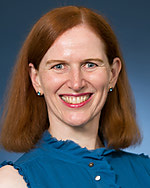Pedi Radiologist, Staff and NECSTR Assist Surgeons
Date Posted: Monday, August 28, 2017 Pediatric Radiologist Dr. Christine Wallace and Dr. Jeremy T. Aidlen were part of a multi-specialty team that helped to treat a young baby girl with a rare birth defect know as persistent cloaca. A 3-D Model of the young girl's anatomy was printed by Assistant Professor Juyu "Ruby" Chueh, PhD in the Radiology department's New England Center for Stroke Research. Also contributing to the 3D project was Matt Gounis, PhD, the liaison who enabled the project, and Olivia Brooks who did work on the project before leaving to attend medical school. Diane Beaulieu was instrumental leading the CT tech team.
Pediatric Radiologist Dr. Christine Wallace and Dr. Jeremy T. Aidlen were part of a multi-specialty team that helped to treat a young baby girl with a rare birth defect know as persistent cloaca. A 3-D Model of the young girl's anatomy was printed by Assistant Professor Juyu "Ruby" Chueh, PhD in the Radiology department's New England Center for Stroke Research. Also contributing to the 3D project was Matt Gounis, PhD, the liaison who enabled the project, and Olivia Brooks who did work on the project before leaving to attend medical school. Diane Beaulieu was instrumental leading the CT tech team.
In an article in the Worcester Telegram and Gazette:
"Surgery typically takes 24 hours or more, but guided ahead of time by a 3-D model of the girl’s anatomy printed from sophisticated imaging technology, doctors were able to complete the operation in just under 12 hours. The model, printed by the New England Center for Stroke Research at UMass Chan Medical School, took 36 hours to print, according to Dr. Wallace, a pediatric radiologist. “This model has helped them become familiar from every perspective, so they had the image in their head before we entered surgery,” she said. Dr. Aidlen said there are lots of contingencies in the operation, but knowing the spatial relationships and locations of key structures in the body helped. “Many of our decisions were straightforward because we had the visualization,” he said. “We didn’t have to talk it through with the baby on the table.”
Dr. Wallace explains the project and the process to create the 3D model:
"This 3D project was first discussed as an approach to the patients care back in November/December 2016 by Pedi Surgery. Dr. Aidlen gave me some material from another group which I read. I asked various people what resources we had available and looked at what these techniques offered. I had discussions with Dr. Gounis on what could be done, and how they usually acquire images for 3D printing. Then I had discussions with Dr. Aidlen on what he most needed. I decided that CT scanning would be a better approach than CT fluoroscopy (which is the usual approach), as long as the images would be acceptable to the printing technique. When I established they would be in an acceptable digital format, I came up with a plan for her preparation for imaging and reviewed this with my Pedi radiology colleagues, Dr. Jean Marc Gauguet and Dr. Farhana Riaz. A plan was developed, shared with all parties and when this worked for all constituents, written down and used as the template for the day when the patient was scheduled for the procedures. The patient went to the OR, had catheters placed in all the relevant cavities, IV’s established and then brought from the OR under anesthesia to the CT scanner, where the protocol was followed under my direction. Others in attendance and contributing included Dr. Foley, anesthesiology, Dr. Aidlen, Pedi surgery and Dr. Gauguet, Pedi radiology. Diane Beaulieu was leading the CT tech team."




